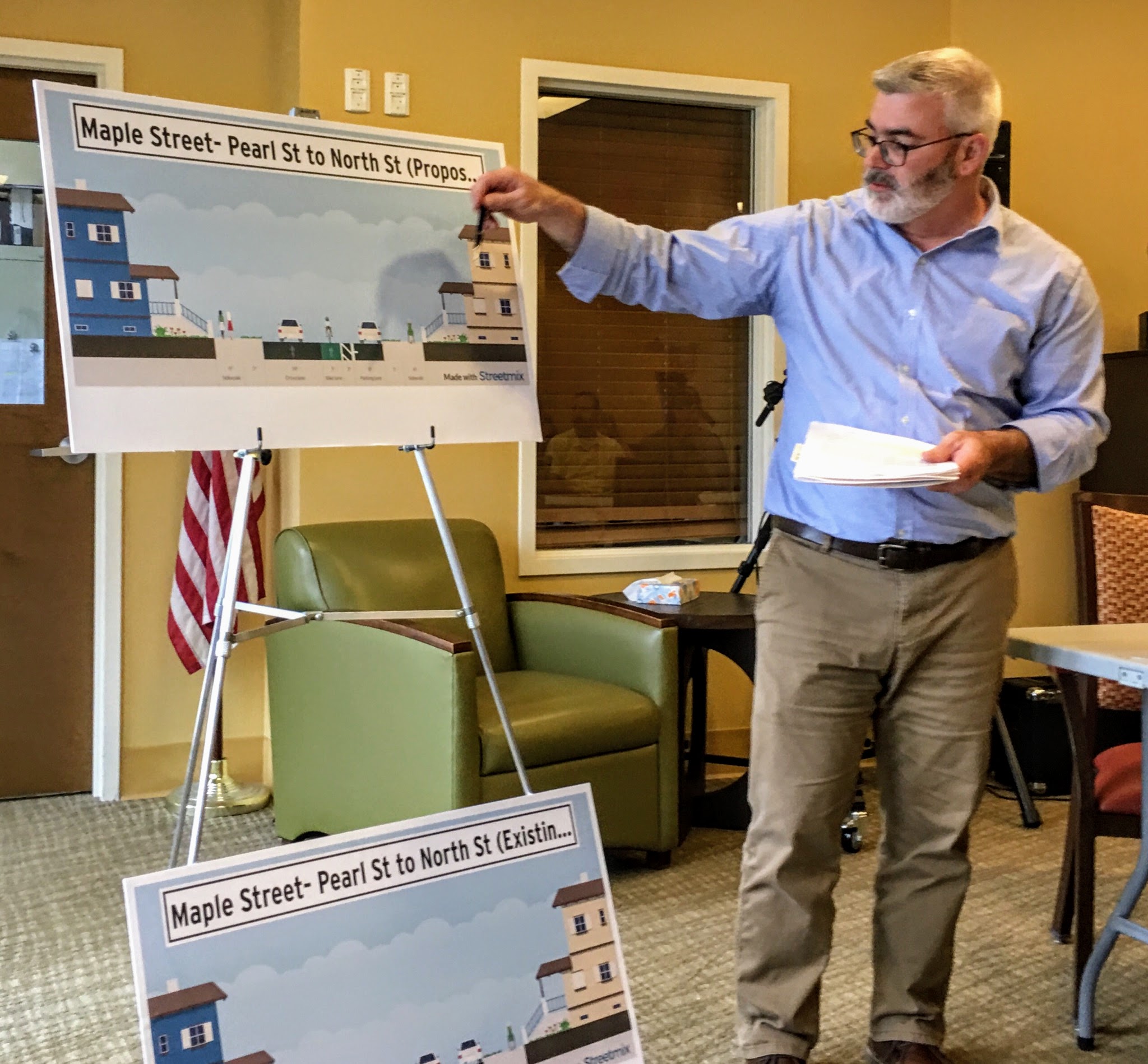
MANCHESTER, NH — Residents welcomed the city’s plan to reduce two travel lanes down to one on Maple Street, in an effort to reduce speeds and collisions.
More than 30 people gathered at the Mt. Carmel Rehabilitation & Nursing Center Thursday night to hear a presentation by Todd Connors, engineering manager of the city’s Department of Public Works. He talked about the pilot project that would reduce Maple Street, from Pearl to Webster street, from two lanes to a single 14-foot driving lane, a 5-foot bicycle lane, a three-foot buffer and parallel parking.
Connors explained that a paving project in late June gives the city an opportunity to try the change in traffic design.
Prior to getting to this point, however, a traffic study was done to determine the number of cars traveling each day on Maple, Beech and Union streets. Maple Street had the heaviest volume with 5,000 cars a day, Beech had 4,500 vehicles a day and Union had just under 4,000 a day, Connors said.
A speed survey also was done which found the average speed on all three streets was 31 mph on weekdays and 32 mph on weekends.
However, Connors said there is something known as the 85th percentile speed which is the speed at which 85 percent of all vehicles travel under free-flowing conditions past a monitored point. Connors said it’s the speed at which operators are comfortable driving.
For the three streets, it came in at 5 mph higher or 36 to 37 mph.
Public works officials also looked at the number of accidents from Bridge to Webster for three years from 2015 to 2017, based on accident reports from Manchester police.
Maple Street, Connors said, had 84 crashes in that time period; Beech, 102 accidents, and Union came in at the highest with 151 collisions. Of the accidents, 44 percent occurred at intersections — either when a vehicle ran a red light or stopped fast, resulting in rear-end collisions.
Twenty-seven percent of the accidents occurred with motorists making a left turn from the right lane. The remainder, he said, is motorists running stop signs or accidents occurring after coming to a stop at a stop sign and then pulling out onto the street without clearly seeing another vehicle coming.
Connors said public works has suggested various safety measures be added, such as back plates on signals to block glare from the sun, making it easier to see the traffic lights and LED stops signs which light up as a vehicle approaches. Funding, he said, is an issue.
The discussion and studies have been ongoing for about the past 12 months.
Connors said a conversation also included putting the bike lane near the curb with a buffer and then parallel parking, which would form a protective barrier for bicyclists. Connors said he and others went to Portland, Maine, which has protective bike lanes in place to see how they worked.
One issue, he said, is the winter maintenance costs. An additional concern for Maple Street, he said, is that there are fewer cars that parallel park. Officials feared motorists would view the empty parking spaces as another lane for traffic.
The idea behind the proposed traffic change, he said, is to make people feel less comfortable going 35 mph.
The city is planning to try it for a month, meet again with residents in the neighborhood and figure out what is wanted in the long run, Connors said.

Jessica Stuart, who lives on Beech Street between Webster and North streets, said she was in favor of anything that can be done to slow down cars.
“The speeding is outrageous,” she said after the hour-long meeting. “I’m afraid I’ll end up with a car in my living room.”
She wasn’t alone. Others said at night Maple Street turns into a drag strip.
Connors said the department has asked the city to hire an engineering firm to determine whether turning Maple and Beech streets back to two-way traffic would reduce speeds.
One woman said that Maple and Beech became one-way, two-lane streets back in 1974 as part of a major project to reduce pollution. She said at the time people predicted it would result in excessive speeds.
Another asked if Connors actually thinks people are going to bike on Maple Street.
“I think it’s the kind of thing once you build it, people will use it,” he said.
Several people voiced their support for the protected lane for bicyclists.
Stefan Philbrook voiced concern for the elimination of parking spaces given the Roman Catholic Diocese of Manchester and the nursing home, both located in the area, employ a great number of people. Parking spaces are filled during the day, he said.
Ward 2 Alderman Will Stewart hosted the session and thanked residents for sharing their concerns. The goal, he said, is to make conditions safer for everyone.







